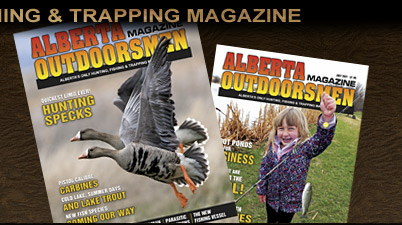|
 |
 |
Those who have looked into golden trout in Alberta know that there are only a handful of lakes in the province that have them. There are a couple of them up Highway 93 near Saskatchewan Crossing and the other few are down south near Castle Mountain Ski Resort. The former are often hit hard by heli-tourists and die-hard hikers. The Barnaby Lakes near Castle Mountain also feel pressure since they are a feasible day-hike option. That leaves Rainy Ridge Lake as the final option.
By the numbers, the lake is only 10 kilometres down a road, followed by a 2-kilometre hike. So why so little pressure? It’s a long drive, requires a mountain bike, an overgrown trail, and unreliable/outdated trail reports. I felt those factors would deter many others, giving us a better chance of catching one of the illustrious fish.
It was decided. I contacted my fitter, younger cousin Colin and invited him to “an uphill bushwhack.” He confirmed instantly and we set the date for a Tuesday that we both had off work just after the lake’s fishing season opened in mid-July.
The excitement was heavy the night before and we both slept terribly. We left Calgary around 6:30 am and arrived at the ski resort parking lot at 9:00 am. After some catching up, we crossed the bridge out of the resort area and began the bike ride down the valley. It started fine, as the road was wide and smooth for the first kilometre or two. However, the road conditions changed drastically once we reached the intersection for Middle Pass.
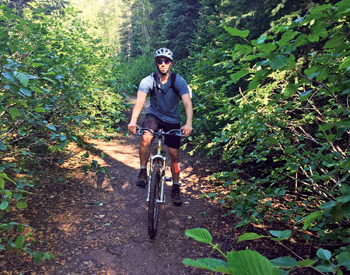 |
| The easiest part of the trail to Rainy Ridge Lake. |
The main road turned right to cross a bridge over the West Castle River on its way to Middle Pass. The road to Rainy Ridge Lake was left, where there was an information sign. Ever since the provincial government restricted OHV use in the Castle Wildlands a few years ago, this road has become a bike trail and is now quite overgrown. It frequently is only as wide as the handlebars and has experienced quite a bit of water erosion. This has left many football-sized rocks jutting out that would be difficult for anything less than a mountain bike to tackle.
The biking was pleasant and the grade was manageable, as the road slowly climbed up the valley. Around 6 kilometres past the info sign, we arrived at another bridge across the West Castle River. Note that some of the beams are missing and you would NOT want to ride your bike across. From this bridge, we had a clear view up into the bowl that the lake sits in. Uninformed souls choose to beeline it toward the bowl’s outlet stream and follow it all the way up. One blog I read described that option as “rock-climbing waterfalls through thick bush.” No thanks!
We did ourselves a favour and found the trail instead. Continuing on the road after the bridge, a prominent trail immediately split left to follow the river. We stayed right along the road. At this point, the road became so overgrown that our forearms were plowing through the bushes. Keeping an eye on the right, we finally noticed a very faint trail after nearly 2 kilometres. Success! If looking at satellite imagery such as Google Earth, the trail ascends the edge of the prominent avalanche path, east/southeast of the lake. We stashed our bikes and started up the trail. In about 20 metres, the trail became less than an animal path. This was the first of many times that we doubted we were on the right trail.
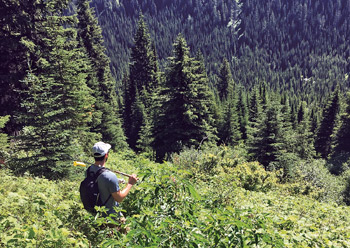 |
| Colin working his way down the overgrown trail. |
As you can see in the photos, we were often wading through waist-high leaves and only following a faint parting of them as the trail. Pants are a must. The trail ascended steeply for one terrible kilometre. We were quite surprised how little switchbacking the trail did, often heading straight up. The only relief was that the trail wandered in and out of the trees on its way up the avalanche slope, giving brief reprieves of shade. Fit souls with light day-trip packs could scale the climb in 30 to 45 minutes. Less fit types with heavy camping packs could take nearly two hours to make it all the way up.
Just before a rock band, the trail swung north and leveled off on its way to round the horn that hides the lake. We were so excited to be on a level path again. However, to our dismay the trail suddenly disappeared about ten minutes along this path. We searched around and couldn’t seem to find the trail. Marking a GPS point, we looked up and saw that we were rounding the horn and that the lake must be nearby. Thus, we started bushwhacking.
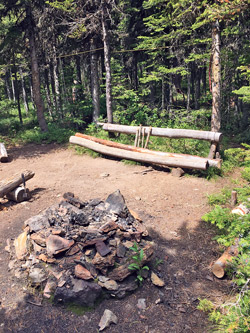 |
| The improvised campsite at the lake. |
By taking the actual trail back from the lake later, we found where we had gone wrong. We hope you learn from our mistake. We found out that a large tree had fallen across the trail, which you have to turn right and walk along to find the trail again. We carved an arrow onto this log where it crosses the trail. In general, if you find that the trail disappears, you have wandered off the trail. Although faint at times, the trail will take you all the way to the lake.
Because of our bushwhacking, we wandered uphill. Once we spotted the lake, it was a hundred metres lower than we were. We had to clamber down thickets to get to the lake, holding onto branches and bushes as we descended rapidly. Finally, after crossing a couple of rock fields, we made it to the emerald shore. We scanned the shoreline... we had the lake to ourselves!
At the first glimpse of the lake around noon, we could see fish rising. From the shore, we even saw a couple jump clear out of the water and some fry could be seen wandering tight to the rocks. It’s always exciting and reassuring to see evidence of fish when you get to a lake.
We headed to the eastern side where a rockfall juts a point out toward the middle of the lake. Other blogs mentioned the best fishing was there. Colin was famished and quickly scarfed down his lunch. I, on the other hand, had not only forgotten my sandwich in the car, but also couldn’t resist the adrenaline of getting some casts into the water.
My fly rod was a mess. My nymph had been ripped off on a bush somewhere and my tippet snapped off too. I spent the first five minutes painfully tying on a new tippet and small mosquito pattern while fish jumped all around me. By the time I approached the water, Colin was already done his lunch and had started spin casting.
Here is where things differed from all the advice I had received. Multiple reports said golden trout were so easily spooked that there was no point in bringing anything other than a fly rod and tiny flies. Nonetheless, I opted to cover all bases and bring the spinning rod for Colin to use. At first, he and I had no bites. Colin took a nap on the rocks and I fly-fished for 30 to 45 minutes. The fish were rising in the little bays and the middle of the lake seemed to have the most action.
The lake gets wind across most of it, making it difficult to see your fly except during the brief lulls. Additionally, a small grassy overhang stretches across the western shore of the lake, which makes an eerie lapping sound as the waves hit it. It sounds like something is walking through the water. These factors combined made it difficult for me as an amateur fly-fisherman.
I gave up rather hastily and asked Colin if I could try the spinning rod. He had no qualms as he was dozing peacefully, stretched out like a marmot on the rock pile. It was absolutely silent; not even airplanes could be heard. I threw some casts for ten minutes before saying to Colin, “Alright man, five last casts.” I don’t know what it is about saying those kinds of things but I have done very well after making such statements. I targeted the centre of the lake.
On the second last cast, I felt the sudden jerk of the rod. Although I had let the lure sink a bit, it was so deep at that spot that I knew it couldn’t be a snag on the rocks. I set the hook. My eyes jumped out to where the lure should be and I saw the unmistakable golden shimmer below the surface.
“I’ve got one on!” I yelled to Colin, as he sprung out of his slumber.
“Are you serious?” he chuckled.
“Get the net!” I confirmed.
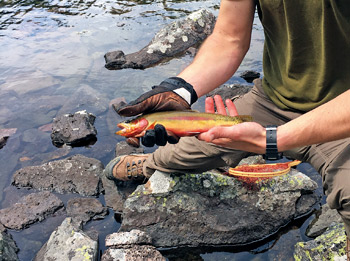 |
| The incredibly beautiful golden trout were introduced into a few lakes in Alberta in 1959. |
Colin hopped through the rock field, as he, the fish, and I were all equally surprised about what was happening.
Safely in the net, we gazed at the beautiful golden trout before us. The colours were vibrant and bold. A true trophy of a fish. We snapped a few photos before getting it back to the water for someone else to catch.
So, what did I end up catching it on? A tiny #1 Panther Martin with a black and yellow bead and a gold spinner. I’ll credit a helpful employee at a northeast Calgary Fishin’ Hole store with the lure recommendation. Based off his and another store’s advice, I had also equipped both my fly-rod’s tippet and my spin rod with ultra-light line. Other blogs spoke of fly-fishing for days to catch a golden and said things like “leave those flashy spinners and spoons at home.” Well, one of those “flashy spinners” caught one in less than a half hour.
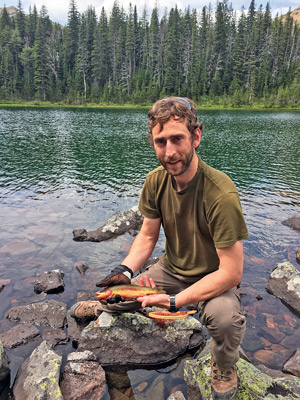 |
| Connor Venables with his golden trout. |
Fulfilled, we packed up and followed the shore to the outlet stream to see if we could find the real trail and forego the bushwhacking portion. Near the stream, we found two firepits and an improvised campsite, including a drying line and bench. If you use that spot, be very careful not to disturb the outlet stream, as it is said to be the only natural reproduction area for these fish in the whole province.
Sure enough, we found the actual trail near the campsite and followed it back to the downed log where we had wandered off the trail. The hike down and bike ride back was twice as fast as the way in. A little tough on the knees going down but the ride out was fast and mostly downhill.
Back to the cars in the late afternoon, we drove to a spot on the Castle River to cheers with beers before splitting up and starting the drive back to Calgary for dinner. ■
For previous Reader Stories click here.
|
|
|
|


